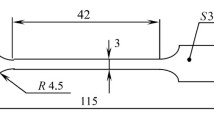Abstract
New drafts of the ASTM standards propose to study stress corrosion cracking with an aim to determine K ISCC and da/dt = f(K I) for increasing loading (crack-opening displacements). The duration of the tests becomes smaller but the spread in data remains the same as in the case of constant loading and constant strains. The results of testing under increasing loading (opening displacement) strongly depend on the correct application of the method, especially on the proper choice of the rates of the process.
Similar content being viewed by others
References
M. O. Speidel, “SC crack growth in aluminum alloys in,” in: The Theory of Stress Corrosion Cracking, Brussels, NATO (1971), pp. 289–344.
J. G. Erfings, W. H. de Groot, and J. Nauta, The effect of slow plastic straining on sulfide stress cracking and hydrogen embrittlement of 3.5% Ni steel and API 5LX60 pipeline steel,” Corr. Sci., 27, 1153–1167 (1987).
R. N. Parkins, “Development of strain rate testing and its implications,” in: G. M. Ugiansky and J. H. Payer (editor), Stress Corrosion Cracking—The Slow Strain Rate Technique, American Society for Testing and Materials, ASTM STP 665, West Conshohocken, PA (1979), pp. 5–25.
P. Mclntyre and A. H. Priest, Accelerated Test Technique for the Determination of K ISCC in Steels, British Steel Corporation Report MG/31/71, London (1972).
W. G. Clark, Jr., and J. D. Landes, “An evaluation of rising load K ISCC testing.,” in: H. L. Craig, Jr. (editor), Stress Corrosion—New Approaches, American Society for Testing and Materials, ASTM STP 610, West Conshohocken, PA (1976), pp. 108–127.
W. Dietzel and S. K. Ghosai, “Stress corrosion cracking—a new approach to test methods,” Fiz. Khim. Mekh. Mater., 33, No. 4, 107–114 (1997).
H. H. Johnson, “Calibrating the electric potential method for studying slow crack growth,” Mater. Res. Stand., 5, 442–445 (1965).
D. R. Anderson and J. P. Gudas, “Stress corrosion evaluation of titanium alloys using ductile fracture mechanics technology,” in: S. W. Dean, E. N. Pugh, and G. M. Ugiansky (editors), Environment Sensitive Fracture. Evaluation and Comparison of Tests Methods, American Society for Testing and Materials, ASTM STP 821, West Conshohocken, PA (1984), pp. 98–113.
G. Abramson, J. T. Evans, and R. N. Parkins, “Investigation of stress corrosion crack growth in Mg alloys using J integral estimations,” Metallurg. Trans., 16A, 101–108 (1985).
R. A. Mayville, T. J. Warren, and P. D. Hilton, “The influence of displacement rate on environmentally assisted cracking of precracked ductile steel specimens,” Trans. ASME, 109, 188–193 (1987).
W. Dietzel, “ESIS guidelines for fracture mechanics based stress corrosion testing,” Technol., Law Insur., 1, 151–157 (1996).
R. A. Mayville, T. J. Warren, and P. D. Hilton, “Determination of the loading rate needed to obtain environmentally assisted cracking in rising load tests,” J. Test. Eval., 17, 203–211 (1989).
K. Strieder, K. H. Daum, W. Dietzel, and J. Mueller Roos, “The use of slow strain rate tests for measuring the velocity of environmentally assisted cracking. Structural integrity: experiments—models—applications,” in: K. H. Schwalbe and C. Berger (editors), Proc. of the 10th Europ. Conf. on Fracture (ECF 10, Berlin, September 1994), Berlin: Deutscher Verband für Materialforschung und —prüfung, E. V., Berlin (1994), pp. 715–720.
J. C. Scully, “The interaction of strain rate and repassivation rate in stress corrosion crack propagation,” Corr. Sci., 20, 997–1016 (1980).
W. Dietzel and S. K. Ghosal, “Effect of displacement rates on the EAC of AISI 4340 steel,” Fatigue Fract. Eng. Mater. Struct., 21, 1279–1286 (1998).
Author information
Authors and Affiliations
Rights and permissions
About this article
Cite this article
Dietzel, W., Mueller-Roos, J. Experience with Rising Load/Rising Displacement Stress Corrosion Cracking Testing. Materials Science 37, 264–271 (2001). https://doi.org/10.1023/A:1013214910345
Issue Date:
DOI: https://doi.org/10.1023/A:1013214910345




